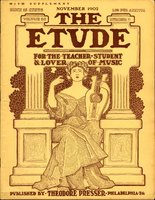BY W.D. ARMSTRONG
Modern technic has made unusual demands upon the thumb, and fortunate is the individual who has that member well shaped, flexible in all its joints, and under perfect control. The method one studies for the development of the hand usually treats the thumb along with the rest of the fingers; the main goal to be reached is equal strength of touch and a certain facility in connecting the tones:
When we consider that the thumb has not only the up-and-down movements of the fingers, but a wide sweep sidewise, also acting in the capacity as a pivot for the weight of the whole hand and arm, one can readily see that special studies are necessary and good effects will result therefrom. The thumb can be used on any key, the old adage that it can be used only on white keys now being relegated to the limbo of oblivion. The following exercises and suggestions have been introduced in order that they may be of use to all music students:
Both the legato and staccato touch may be employed, the speed at first taken quite slowly, then accelerated, until the fingers fall readily and mechanically in their places. Practice in all the major and minor scales.
This chromatic arrangement of exercise number one will be very beneficial, and should be played through several octaves.
The above may be played, as fingered, in all the major and minor scales, to be followed by playing the B, G-flat, D-flat, A-flat, E-flat, and B-flat major scales, with the same fingering as that used in the C major, beginning each time on the first finger of the right hand, and the fifth finger of the left hand, using the thumb on black keys.
It requires very careful study to bring out the lower voice as nearly legato as possible, when the thumb only is used.
If the notes are too far apart to play the lower fingering, the first group may be omitted.
This Ribattuta1 passage will greatly strengthen the fingers, and leads directly to trill work. It is also advisable to practice it with different gradations of tone-force. Play it entirely through forte, then piano. Afterward try for a gradual crescendo, then a diminuendo. Last, the swell going from pianissimo to fortissimo, and vice versa.
In the foregoing illustrations, the treble clef has been used exclusively, and the fingering for the right hand only indicated. Space will not permit an exhaustive exposition of the subject, but attention, once drawn in this direction, reveals an almost endless variety of material, all of which can be made to contribute toward the development of the thumb.
[1] Ribattuta: Gradually accelerating the pace of a phrase of two notes, until a trill was arrived at.









